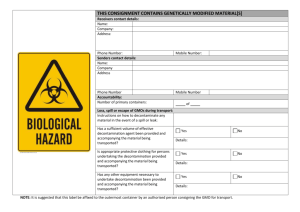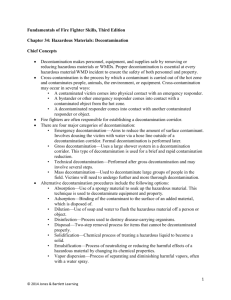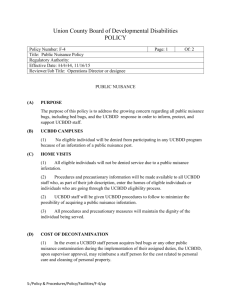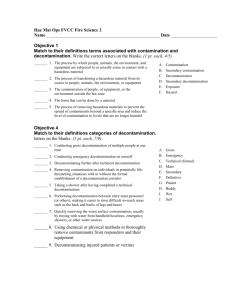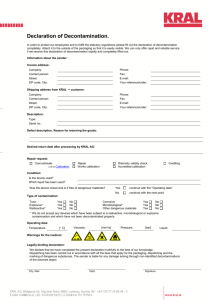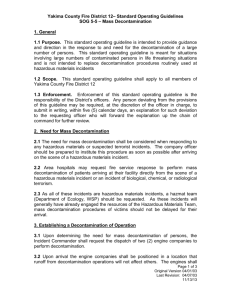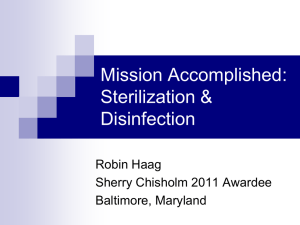March 2003 Instructor`s Guide (MS Word format)
advertisement
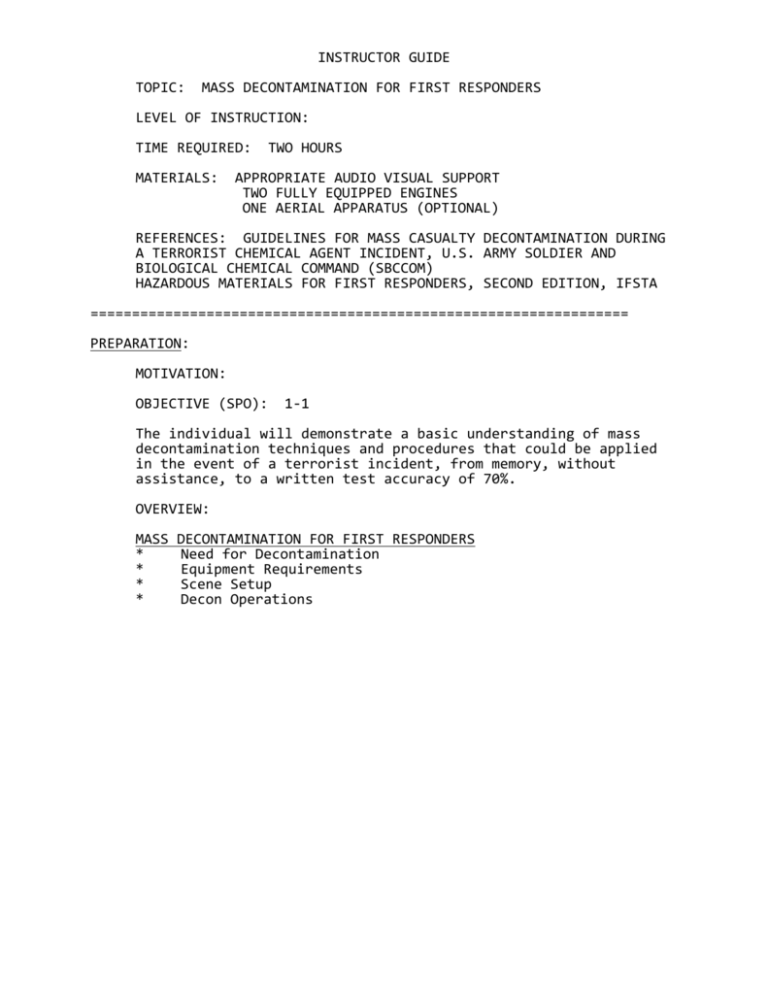
INSTRUCTOR GUIDE TOPIC: MASS DECONTAMINATION FOR FIRST RESPONDERS LEVEL OF INSTRUCTION: TIME REQUIRED: MATERIALS: TWO HOURS APPROPRIATE AUDIO VISUAL SUPPORT TWO FULLY EQUIPPED ENGINES ONE AERIAL APPARATUS (OPTIONAL) REFERENCES: GUIDELINES FOR MASS CASUALTY DECONTAMINATION DURING A TERRORIST CHEMICAL AGENT INCIDENT, U.S. ARMY SOLDIER AND BIOLOGICAL CHEMICAL COMMAND (SBCCOM) HAZARDOUS MATERIALS FOR FIRST RESPONDERS, SECOND EDITION, IFSTA ================================================================= PREPARATION: MOTIVATION: OBJECTIVE (SPO): 1-1 The individual will demonstrate a basic understanding of mass decontamination techniques and procedures that could be applied in the event of a terrorist incident, from memory, without assistance, to a written test accuracy of 70%. OVERVIEW: MASS * * * * DECONTAMINATION FOR FIRST RESPONDERS Need for Decontamination Equipment Requirements Scene Setup Decon Operations DEVELOPING A TRAINING PROGRAM SPO 1-1 The individual will demonstrate a basic understanding of mass decontamination techniques and procedures that could be applied in the event of a terrorist incident, from memory, without assistance, to a written test accuracy of 70%. EO 1-1 Identify the need to establish mass decontamination following a suspected chemical or biological terrorist incident. EO 1-2 Identify the equipment required to decontaminate a large number of people quickly. EO 1-3 Identify the scene setup to decontaminate a large number of people that may have been exposed to a chemical or biological incident. EO 1-4 Demonstrate the operation of a mass decontamination setup. This drill is designed to prepare the first responder to a suspected terrorist incident involving a chemical or biological agent to setup and operate a decontamination operation to decontaminate a large number of people quickly and efficiently. It is assumed that the participates have had some previous hazardous materials training, preferably to the operations level. The information in this drill is limited to chemical and biological agents and does not address the other potential weapons of mass destruction such as explosives, incendiary devices, or nuclear weapons. I. NEED FOR DECONTAMINATION (1-1) A. Potential for Release of Agents 1. Heightened tension in the world 2. Anthrax alarms - real or imagined 3. Threats - real or potential 4. Availability of product 5. Product may be known or unknown B. Types of Releases 1. Airborne release a. Dependent upon pressure behind release b. Movement affected by wind speed and direction c. Presents greatest respiratory hazard d. Release may cause penetration into clothing and skin 2. Liquid release a. Ability to vaporize dependent on ambient temperature or heat source applied to product b. Potential spread of agent directly affected by vapor emission 3. Solids release a. Ability to move from source directly affected by size of particles b. Wind can affect particle movement, especially for smaller particles c. Could be spread through air-handling systems C. Potential for Contamination 1. Expect at least a 5:1 ratio of unaffected to affected casualties 2. Not all exposed will be contaminated 3. Number of people exposed directly affected by a. Type of release b. Confinement of release - inside or outside c. Proximity of people to release d. Duration of release 4. Amount, concentration, and purity of product 5. Release mechanism (some products such as sarin more effective when heated to produce vapor and dispersed using forced ventilation) II. EQUIPMENT REQUIREMENTS (1-2) A. Apparatus 1. At least two fully equipped pumpers 2. Aerial apparatus (optional) B. Equipment 1. Hose and nozzles 2. Salvage covers or opaque material 3. Ladders 4. Rope C. Supplies 1. Decon solutions a. Laundry detergent b. Household bleach 2. Collection items a. Sealable plastic bags for valuables and personal items b. Bags or containers to collect contaminated clothing 3. Spare clothing for individuals who have to be disrobed a. Medical scrubs b. Coveralls c. Hospital gowns d. Sweats e. Blankets or sheets f. Opaque plastic bags g. Additional items for colder conditions 4. Other items a. Plastic electrical ties b. Identification tags or bracelets c. Paper and writing instruments (pens, pencils, permanent markers) to record personal information d. Clipboards e. Scissors or trauma shears to assist in clothing removal III. SCENE SETUP (1-3) A. Setup should be upwind and uphill from incident and in warm zone B. Decontamination Corridor Layout 1. Utilize two pumpers to form the decontamination corridor a. Place parallel approximately 20 feet apart b. Have pump panels facing outward 2. Place ladders a. between apparatus at each end so that covers or other material can be attached or draped to provide privacy b. In middle of and parallel with apparatus on the ladders between apparatus to create a barrier to separate males from females 3. Have an area at the entry point for disrobing a. This is the best means of removing contaminants b. Should disrobe down to undergarments c. If unwilling to disrobe, decon anyway d. Have a means of collecting contaminated clothing such as overpack drums, trash containers or boxes with liners, or large plastic bags e. Have clear sealable plastic bags for personal items and valuables that should not get wet should have a means of identifying the bags 4. Have separate areas for males and females a. Separate by divider in middle b. Consider separate decontamination stations for males and females c. Have multiple water discharge points 5. Have replacement clothing at exit point a. Clothing should be simple to don b. Clothing must be able to fit different sized people 6. Containment of runoff a. If possible and as soon as personnel and equipment become available, an effort should be made to contain runoff b. The initial effort should concentrate on contamination reduction of exposed or potentially exposed victims C. Injured Persons 1. Individuals with injuries need decontamination prior to being treated on the scene and transported to a medical facility 2. Remove as much clothing as possible 3. May require decontamination while on stretchers 4. Treatment takes place in cold zone IV. DECON OPERATIONS (1-4) A. Placing Apparatus 1. Place pumpers parallel approximately 20 feet apart with pump panels facing outward to create decontamination corridor 2. If aerial apparatus utilized, please near pumper with aerial device extended slightly so that master stream device situated over decontamination corridor 3. Apparatus should not be running to avoid carbon monoxide buildup in decontamination corridor a. Utilize hydrant pressure if available and adequate b. Have pressure supplied by another engine aware from the decontamination area B. Equipment Setup 1. Place 2-1/2-inch combination nozzles on all discharges facing decontamination corridor 2. Set nozzles to wide angle fog pattern - nozzle pressure should be approximately 60 PSI 3. May also fabricate device to attach to apparatusmounted master stream device to create shower effect 4. Place ladders between apparatus at each end so that covers or other material can be attached to provide privacy - use rope or plastic electrical ties to secure covers or drape them over ladders 5. Place ladder and salvage in middle of decontamination corridor parallel with apparatus on ladders between apparatus to create a barrier to separate males from females 6. Additional water can be discharged into the decontamination corridor a. From hoselines and nozzles positions on ladders placed above the corridor b. From hoselines being operated on top of apparatus - be cautious to minimize the invasion of privacy 7. Have containers to collect contaminated clothing C. Operation 1. Distribute sealable bags and writing instruments an entry point in which individuals would place personal effects and valuables 2. Have individuals walk through decontamination area slowly for maximum flushing with water - may want to have people being decontaminated make one complete rotation in water discharge area 3. Have spare clothing near exit point so that individuals can dress prior to exiting 4. Personnel operating decon should wear normal structural firefighting clothing 6. Have entry and exit point where water is not being discharged D. Other Considerations 1. Attempt to contain and control potentially exposed individuals 2. While decontamination solutions such as soap or bleach are useful, they may not be available in sufficient quantity or quickly enough to be utilized 3. Removal of contaminated clothing and flushing with water provides adequate removal of contaminants; if clothing is not removed, contaminants can be forced onto body by water spray 4. Showers in locker rooms at schools can be used as an alternative 5. As a last resort, individuals could be passed through the corridor of a building protected by fire sprinklers with selected sprinkler heads operating 6. Maintain the privacy and modesty of individuals as much as possible 7. Decontamination in colder climates or during periods of colder temperatures require special consideration to avoid hypothermia At the conclusion of the classroom portion of this drill, departments are encouraged to set up and operate a mass decontamination station. In addition to the training value, this will provide an opportunity to fine-tune individual department operations. The method discuss here is an example of what can be done. There are other variations that serve the purpose. Each department should have some method of decontaminating a large number of people in the event of a chemical or biological release. Once the method is determined, all personnel should be trained on a regular basis in its setup and operation. Additional information on this and related topics can be obtained from www2.sbccom.army.mil REVIEW: MASS * * * * DECONTAMINATION FOR FIRST RESPONDERS Need for Decontamination Equipment Requirements Scene Setup Decon Operations REMOTIVATION: While many fire departments hope that a terrorist event will never take place in their community, there is always that possibly. With this in mind, it is important that everyone be prepared to quickly and efficiently decontaminate anyone suspected of being exposed to a chemical or biological agent. Time is of the essence to maximize survivability of victims. ASSIGNMENT: ================================================================= EVALUATION:
